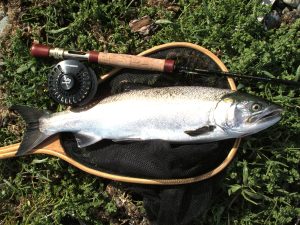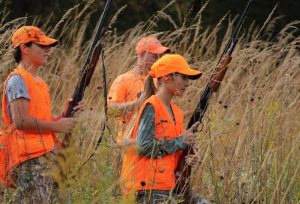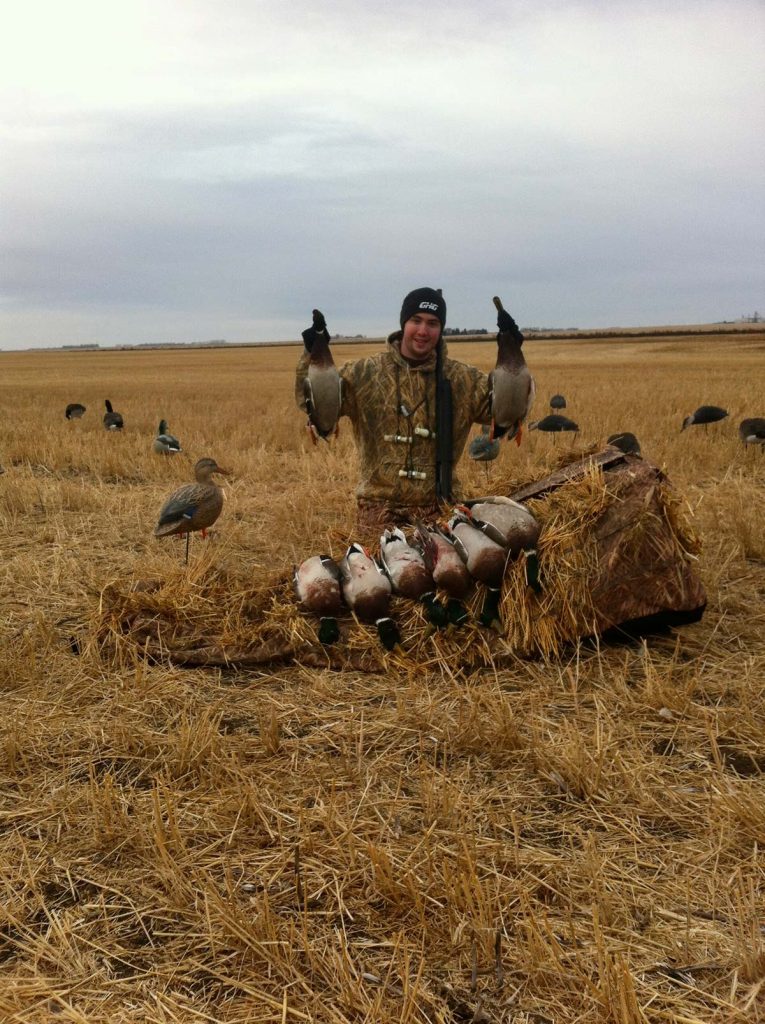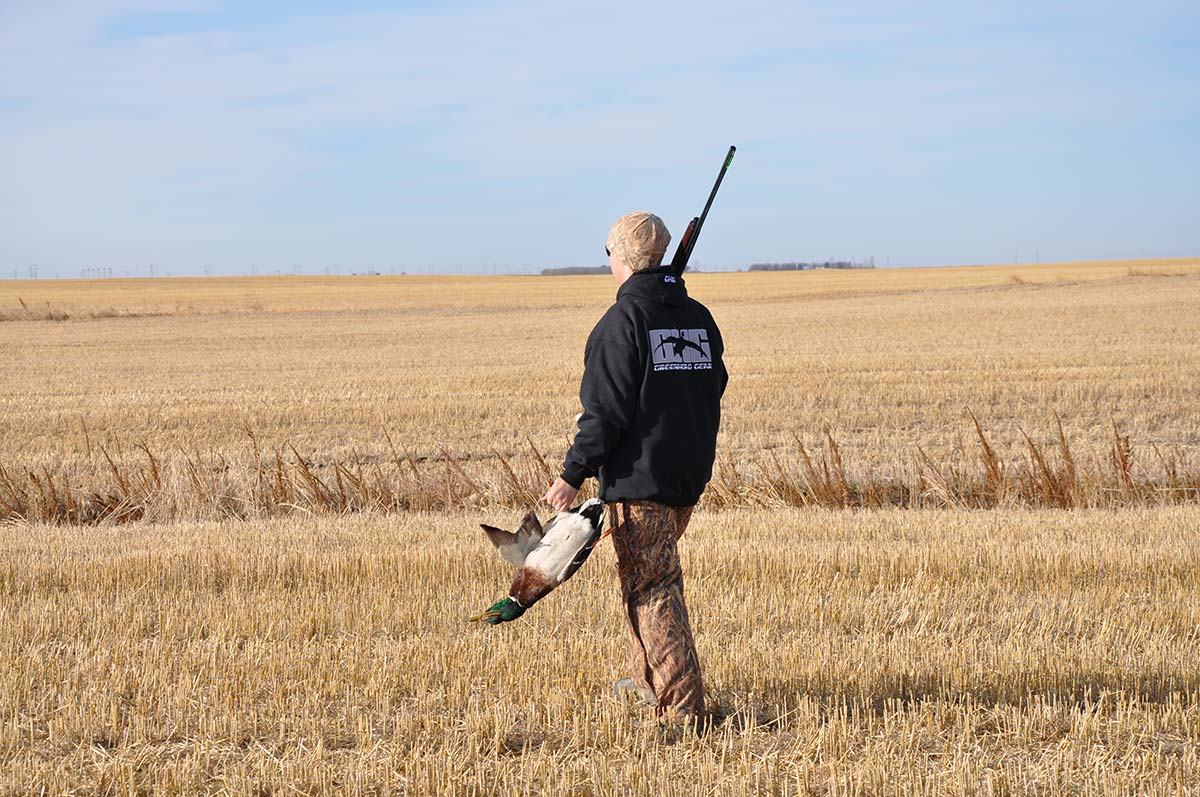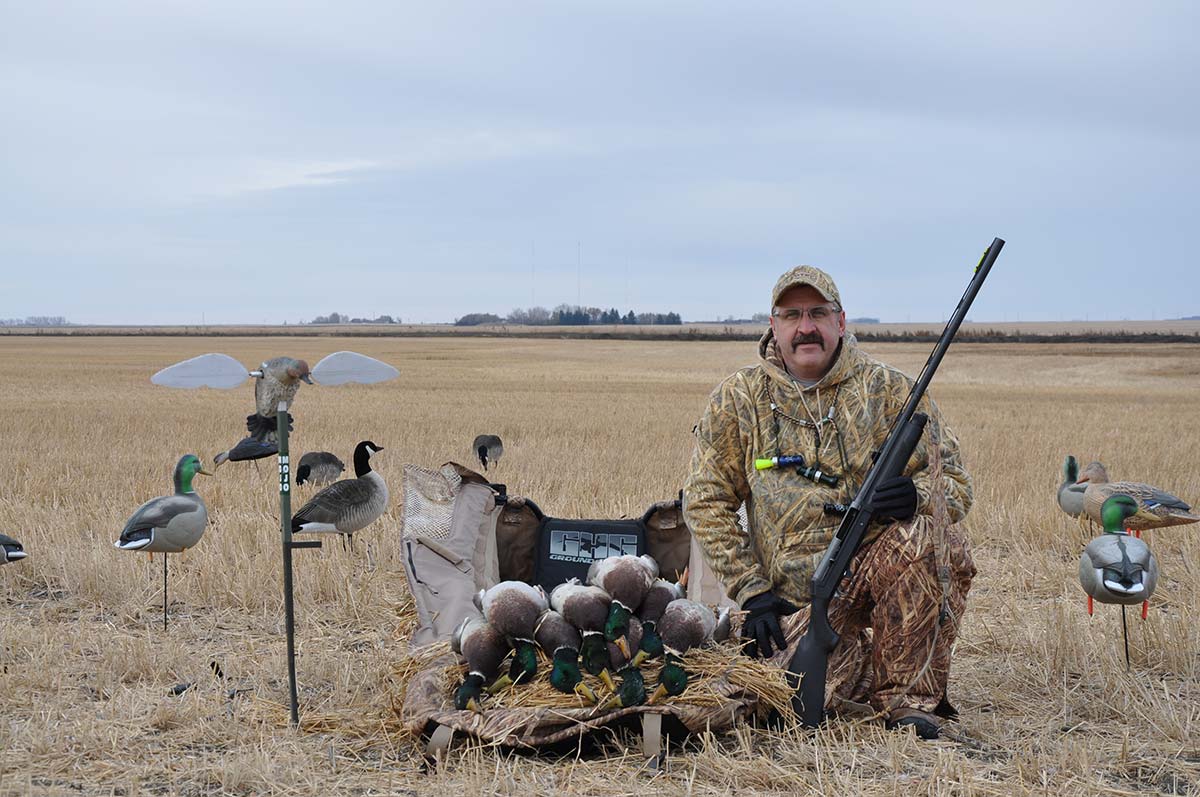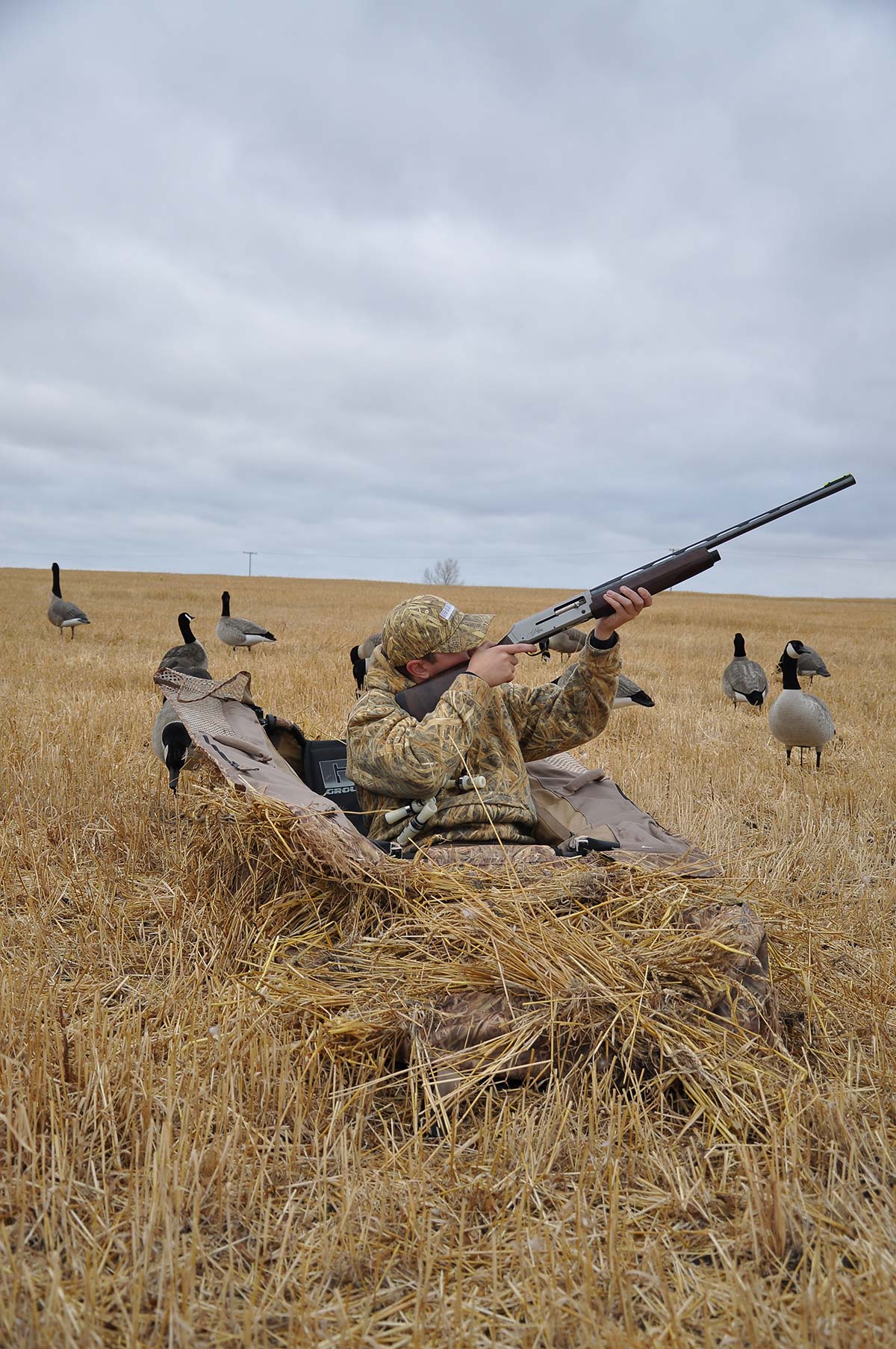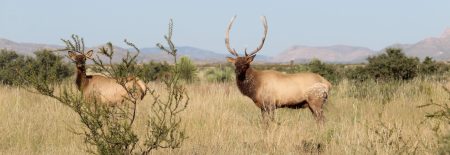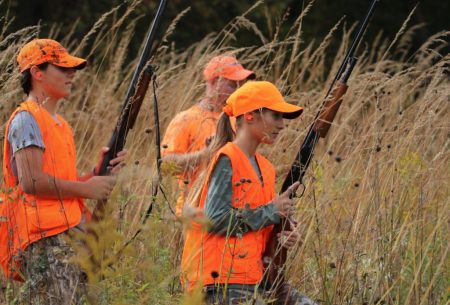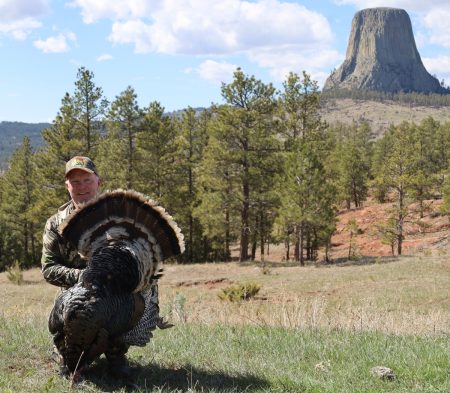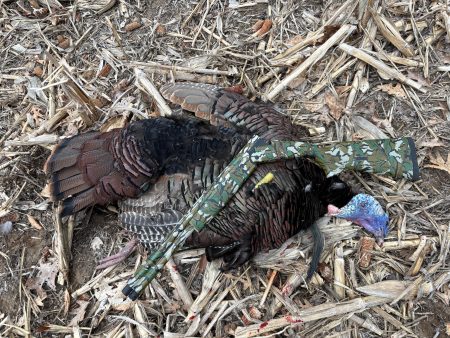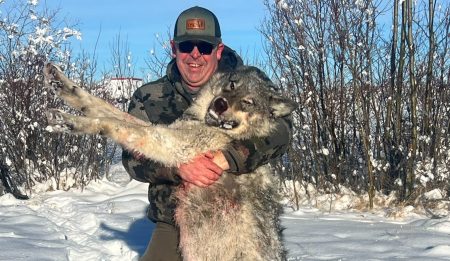I grew up waterfowl hunting and my first exposure to hunting ducks was over a spread of decoys while hiding in a rock pile in the middle of a barley stubble field. That morning watching the sunrise and having flock after flock of ducks work the decoys was super exciting. The memories of that hunt are permanently ingrained in my memory bank. Since that morning so many years ago, I have been on countless stubble field duck hunts, yet I still get excited for my next hunt. Why? Because there is nothing more exhilarating and rewarding than scouting, setting up a decoy spread, having flocks of ducks work the decoys and drop in right into the landing zone.
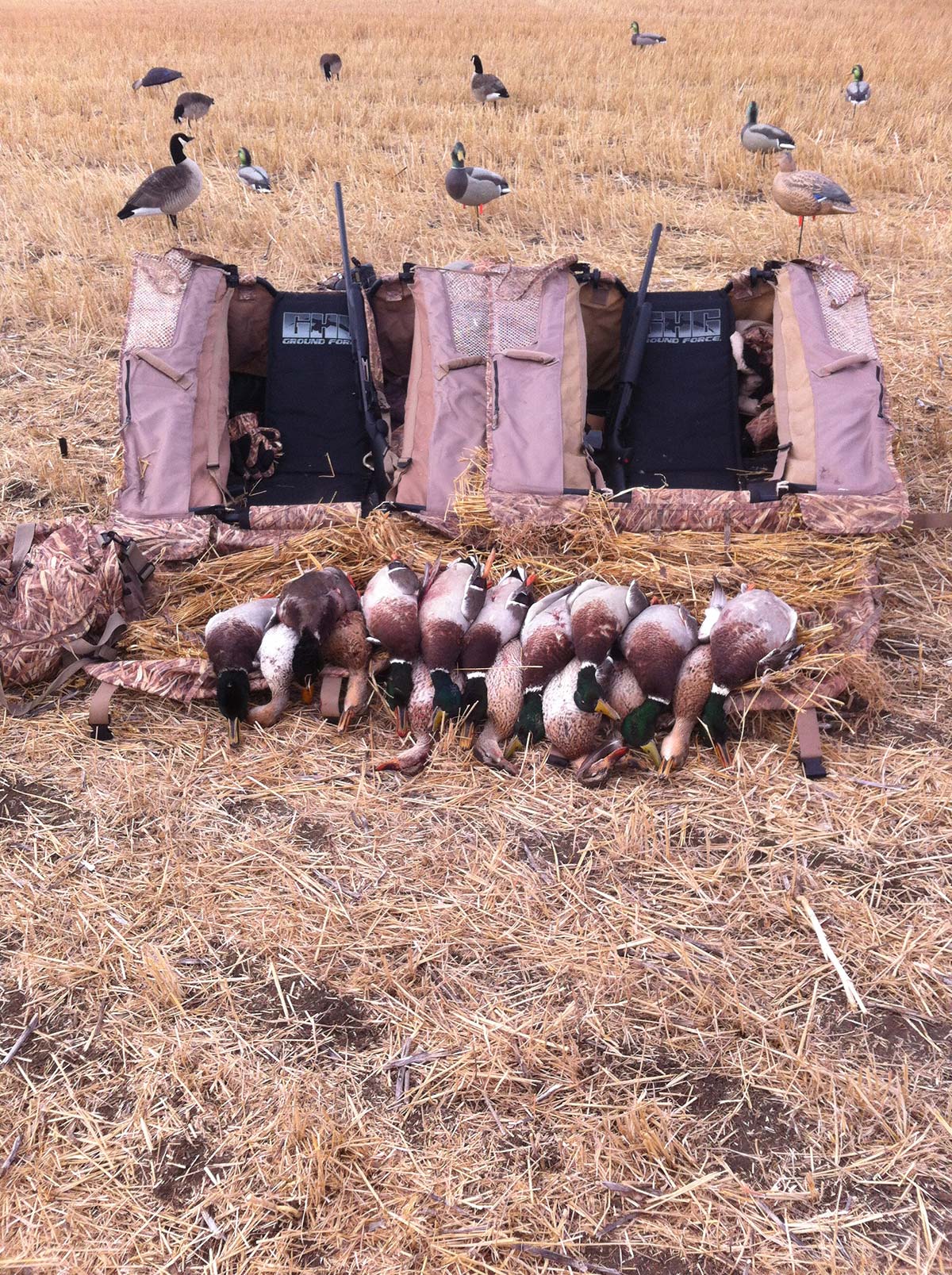
Understanding Ducks
Dabbling ducks such as mallards and pintails spend the vast majority of their time on water. They spend their nights on larger bodies of water that most hunters call roosts. Each morning, they leave the roost to feed in stubble fields. Sometimes they stop at a small water body to have a drink and on other occasions they hit the feeding field first and then toggle back and forth between their feeding field and drinking location. Once done feeding, they will head back to water to spend the day. Sometimes they return to the roost and on other occasions, particularly when there is lots of open water, they will head to smaller bodies of water to loaf. Late afternoon, they leave the water and head out to feed again.
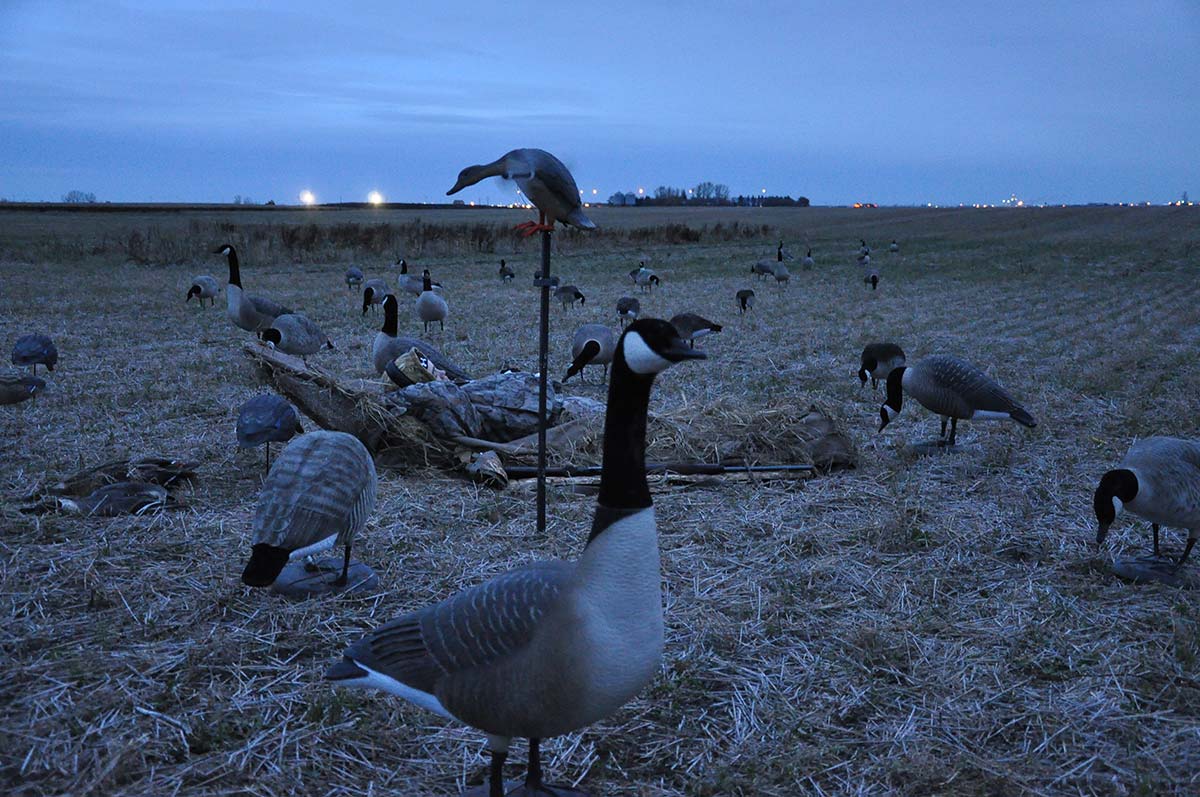
Finding a Field to Hunt
The key to a successful stubble field duck hunt begins with finding where the ducks are feeding in agricultural fields, such as barely, wheat, corn, peas and lentils. The only way to find such a location is investing some windshield time looking for ducks. When undisturbed, ducks will feed in the same field each morning and afternoon until they’ve eaten the field clean. Thus, I typically like to scout the evening before a morning hunt or the morning before an afternoon hunt.
One of the most productive scouting methods is to watch and follow ducks as they leave their water sanctuaries and fly out to feed. If you know where the ducks are roosting or loafing, simply park on the highest hill in the area and watch for ducks as they leave the water. If you don’t know where the ducks are sitting on water, you’ll have to spend time driving the area until you can spot some ducks in the air.
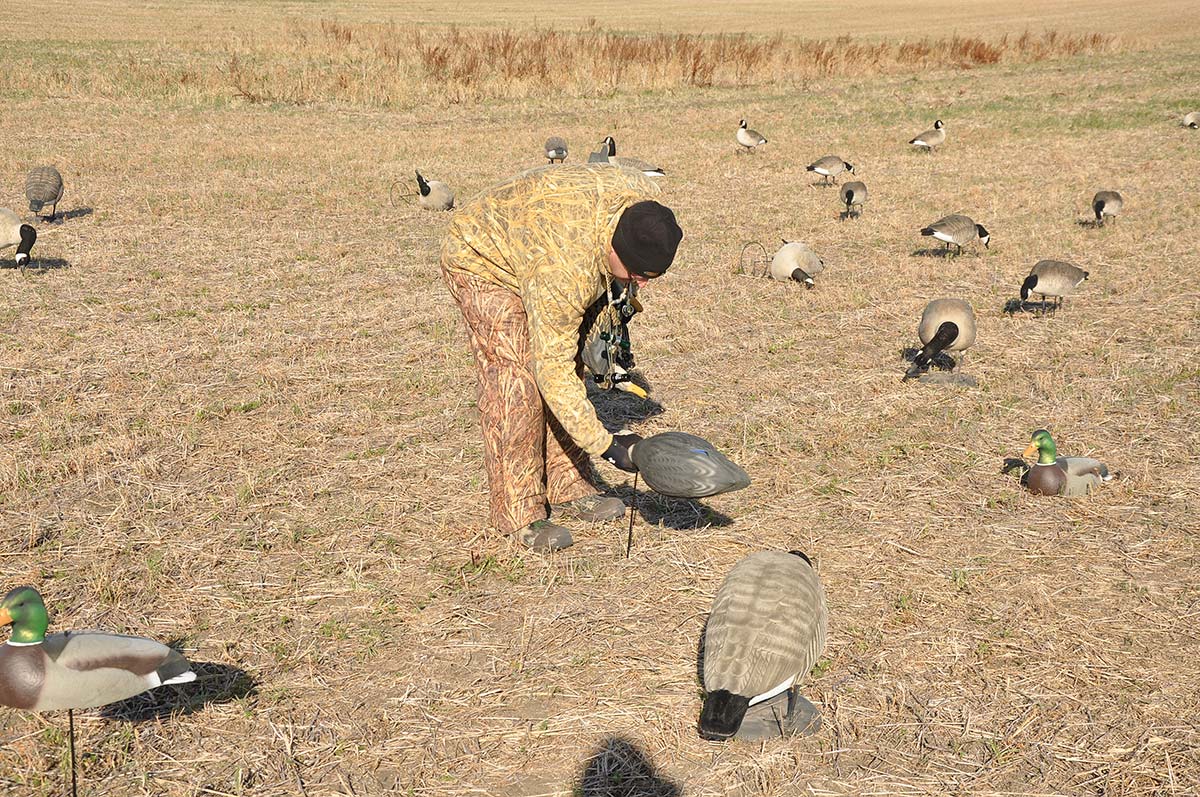
Once spotted in the air it’s a matter of following them to their feeding field. Since the ducks can go straight to their feeding field or to a drinking location, don’t just follow the first flock of airborne ducks you see. Wait and watch until you see enough groups of ducks flying to figure out a directional pattern then start following the ducks. If they happen to stop for a drink first, let them dump into the drinking pond and watch them from a distance so you don’t spook them. Often this pit stop is only for a few minutes, so sit tight and then follow them again once they leave the drinking hole.
Early in the season, ducks will often feed within close proximity to their roost. As the season progresses, they’ll fly further and further from the roost to feed so don’t be surprised if they fly several miles while following them. Part of the reason for extended flights is they have eaten local fields out of food or been shot at in certain fields and won’t return there. Another reason they fly further to feed is they are conditioning themselves to migrate once the weather gets miserable.
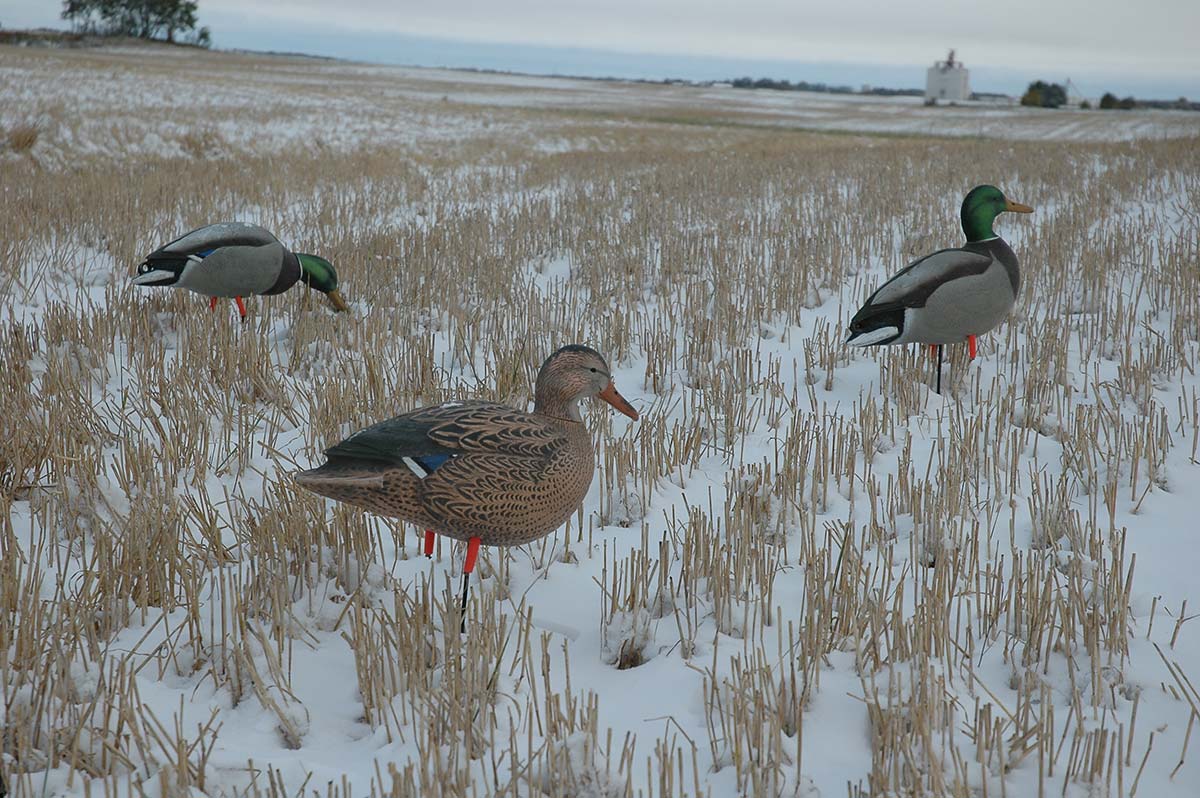
Ducky Details
Once you find where the ducks are eating, watch them until they are done feeding. Take note how they are feeding. Look to see if they are feeding in one big group. Observe if they are spread out on swaths or where swaths once were as you will want to set up your decoys in the exact same fashion. Be patient and keep watching the ducks until they leave. Take note of the final area where they were feeding as that is where you’ll want to set up your decoys.
As you watch the feeding ducks, you will see how they are constantly on the move while eating. The birds at the back of the flock can be seen waddling to the front to get ahead of the others. At times the urge to feed is so high that walking isn’t fast enough! So, birds near the back will jump up and hopscotch/fly to the front of the pack. All the while that this is happening, more ducks from the roost will be joining the group on the ground and land as close to the front of the feeding flock as possible.
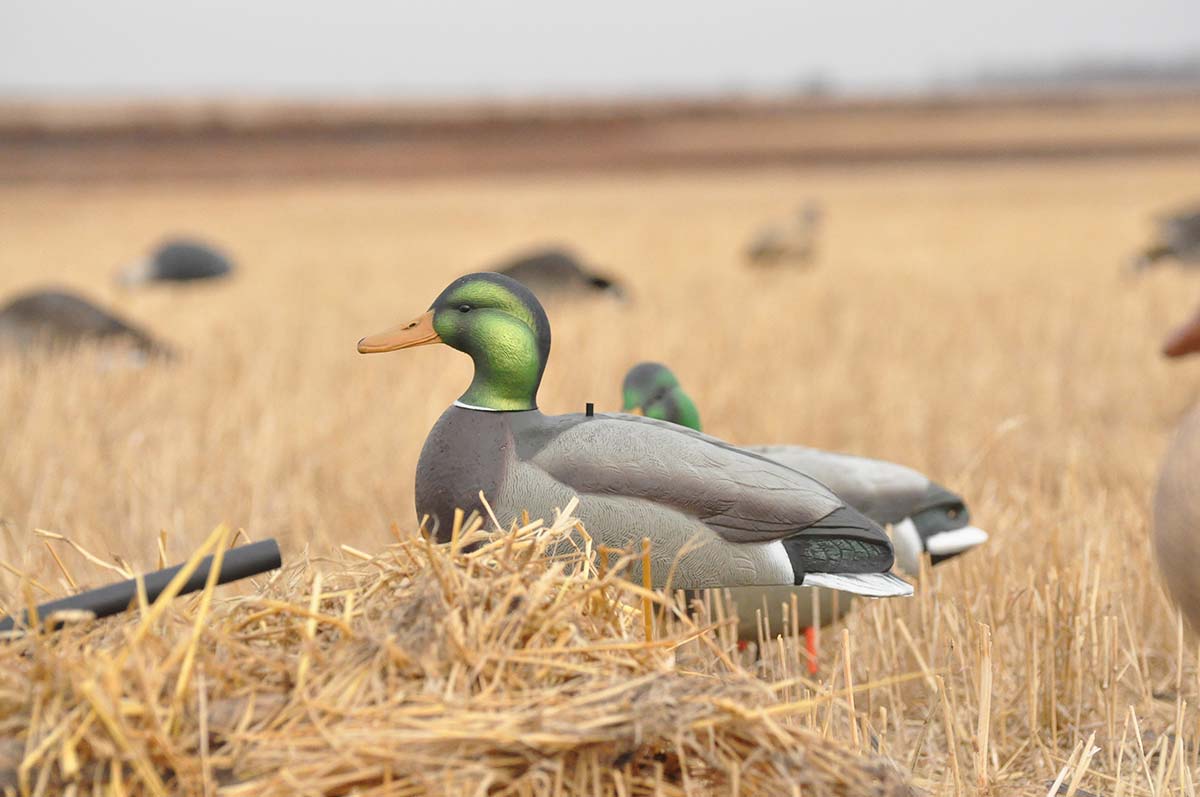
Setting Up To Hunt
When returning to the field to hunt, the first thing to do is position your blinds. I like to keep the blinds as far upwind as possible and then deploy my decoys all around the blinds in a similar pattern to how I last saw them feeding. While doing so, I like to set up the majority of the decoys downwind of the blinds. To funnel the ducks to land where I can shoot them, I will create landing zones down wind of the blinds by leaving open spaces within the decoys. While doing so, I will ensure these landing zones are well within effective shooting range.
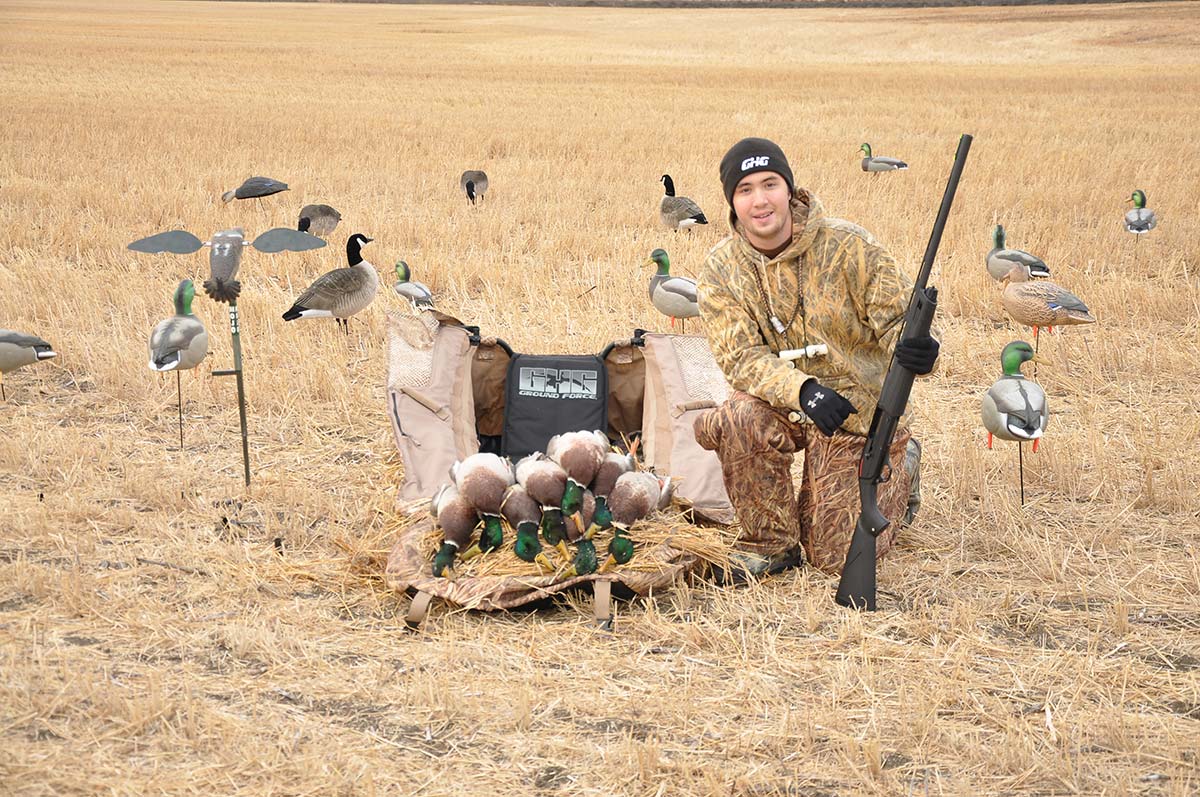
At the beginning of the season, I like to go with several smaller landing zones upfront as the ducks will come in smaller groups. As the season progresses and the flocks of ducks become larger, I’ll go with one larger landing zone. For early season hunts, I set the spread up so the wind is right over the backs of the shooters. As ducks drop into the landing zones, it results in feet down head on shots. Later in the season when the birds are a little more educated. They look for danger on the upwind side of the landing zones and flare if they see anything out of the ordinary. To overcome this, I will position the blinds to the side of the landing zone with the wind blowing sideways over the shooters’ shoulders. With the ducks’ attention focused forward, they don’t flare and offer up crossing shots.
Once the main spread is set up additional decoys downwind to represent other ducks waddling up to the massive group to join the buffet. These secondary decoys can be spaced out further apart than the decoys in the main spread. Doing so makes your spread look bigger. It also gives the illusion that the food isn’t as abundant down wind and forces the incoming birds to the landing zones.
Showtime
Once the work is done it’s time to crawl into the blind, wait for the action and then take in the show when the ducks start arriving. As much as feeding ducks are aggressive feeders, they are extremely cautious when working a decoy spread. Before committing to landing, they’ll circle around your blind and decoys several times as they search for danger. Often as they circle more and more ducks will join the swarm adding more and more eyes to scan for danger. As they circle around, you’ll hear the wind whistle as they cup their wings to twist and turn to change altitude and check out your decoys.
When the ducks are putting on a show around your spread, they are looking for danger so keep motionless. Keep your hands and face well-hidden as movement and human skin tones will readily give you away. Calling will help draw the birds closer and makes them feel confident they are circling live birds. However, it is vital that you don’t call when the birds are directly downwind as they will easily pinpoint the source of the sounds which could spook them. Additionally, your calls may prove to be too loud and unnatural which will also cause them to flare.
To keep yourself concealed and still entice the birds that all is well below, start calling as soon as the birds have passed your blinds and continue calling until they round the corners and start heading back directly at you. As the ducks circle your spread be patient as they will swing around a half dozen times or more and at varying altitudes before committing. However, always be ready as once one or two ducks commit, the entire flock will drop from the sky right into your landing zone.
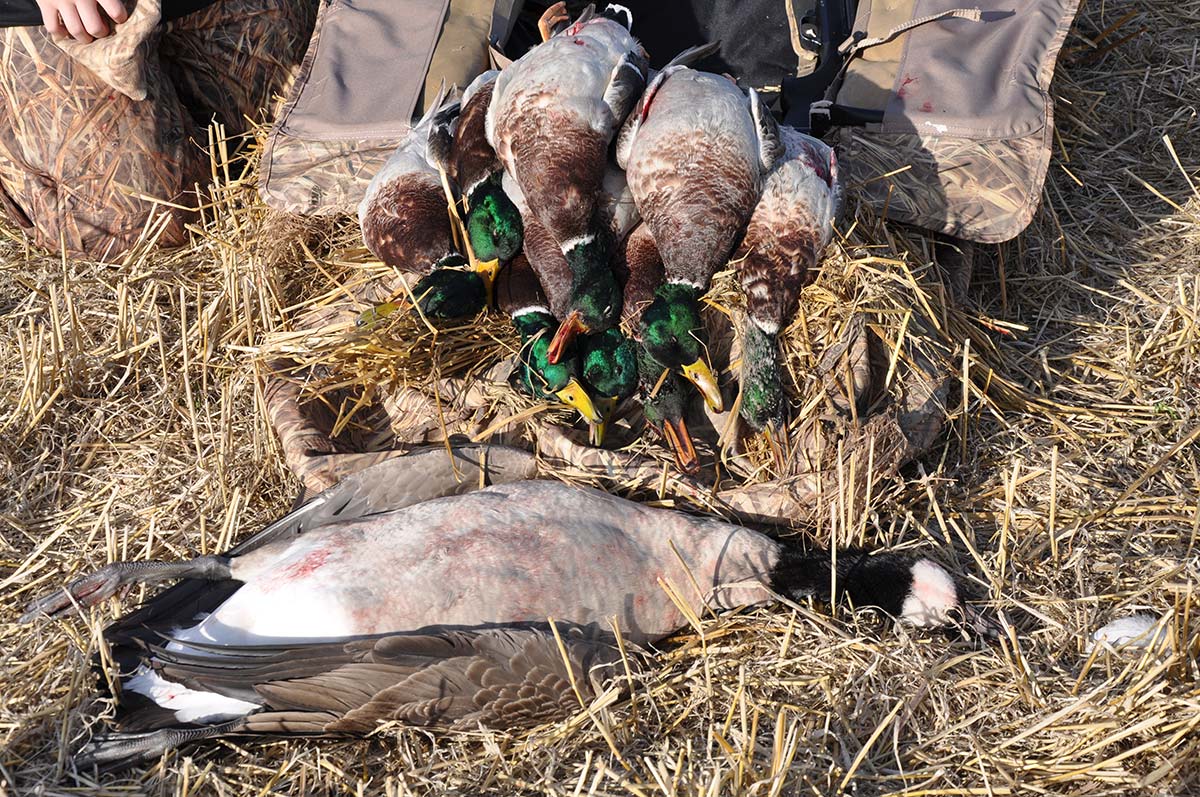
Taking the Shot
As a mass of birds comes dropping down from the skies upon you, let them keep coming closer and closer. If all goes right, the front birds will start landing and the entire flock will be in shooting range. Fight the urge to shoot haphazardly into the flock. Doing so will result in complete misses and potentially crippled birds. Instead, focus on one individual bird at a time and keep pulling the trigger on that bird until it drops. If the ducks are still in range after your bird folds up, single out another one and shoot again.
While shooting, keep in mind that ducks are quite acrobatic and will start to catch the wind as soon as they see you rising from the blind. This means you will need to lead them upwards as they attempt to rapidly gain altitude.
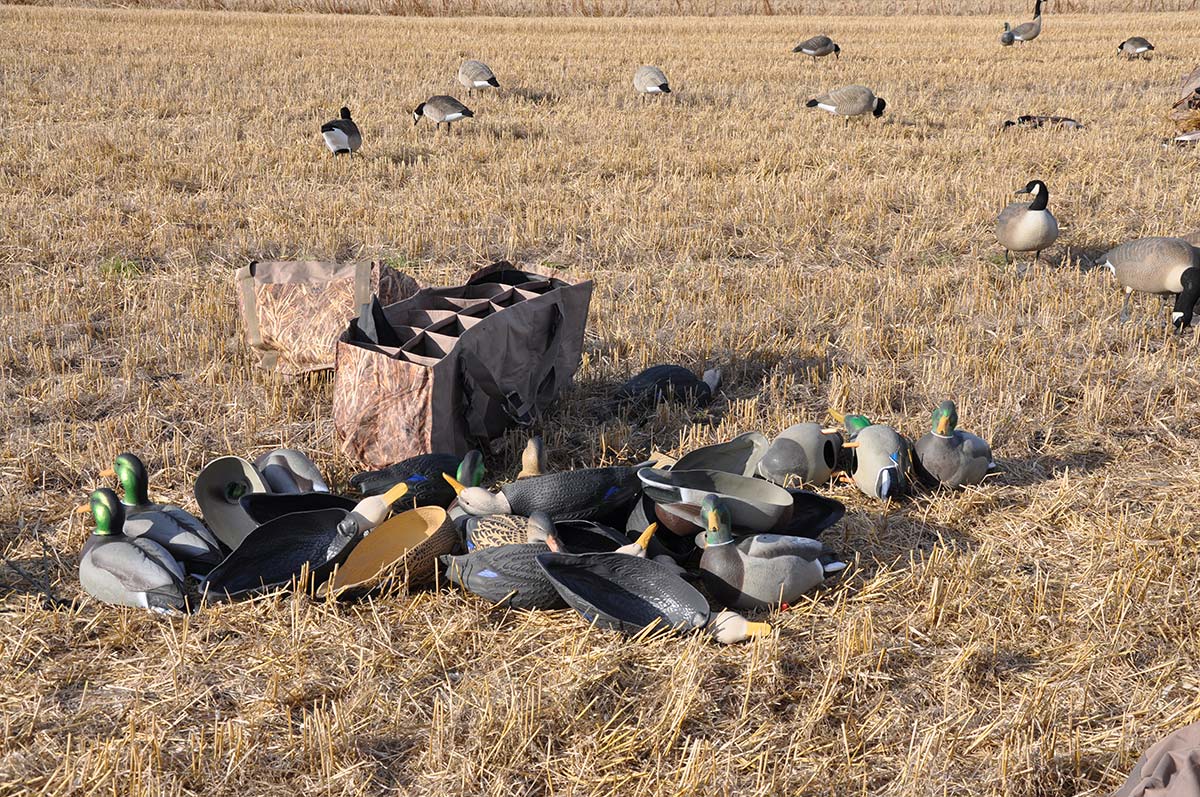
Gear Overview
When hunting ducks in fields, I use a number of different items to help ensure my hunt is a success. I use blinds, field decoys, spinning winged decoys, shotguns, shot shells and duck calls.
Blinds
My go to blinds for stubble field duck hunts are layout blinds as much of the terrain where I hunt is wide open flat fields. I choose this style of blind, because they keep me dry and put a layer of material between me and ground. Also, they are extremely low profile and help conceal me and my buddies as we lay and wait for the ducks to come into shooting range. Once brushed with stubble, these blinds look just like the field and blend right in.
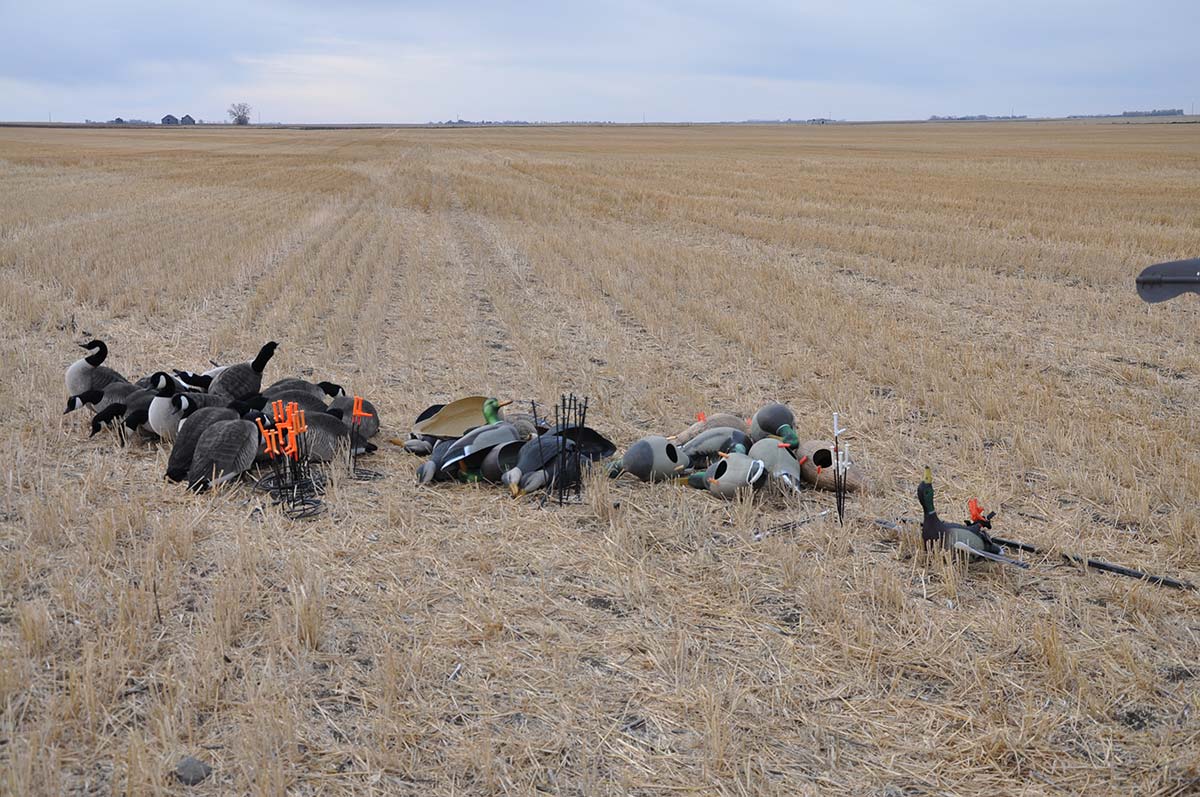
Over the years, I have discovered that by turning the foot end of the blind 45 degrees to the side of where you plan to shoot really helps open up your shooting lane so you can get a full range of motion. For right-handed shooters angle the blind to the right. For left-handed shooters turn the blind to the left.
When hunting in pea and lentil fields where the stubble is short, I use the Avery Power Hunter Blinds as they are so low to the ground. When hunting in corn, barley and wheat fields where the stubble is taller, I use Green Head Gear Ground Force Layout Blinds as they have a slightly higher profile, which makes them a little more comfortable to lay in.
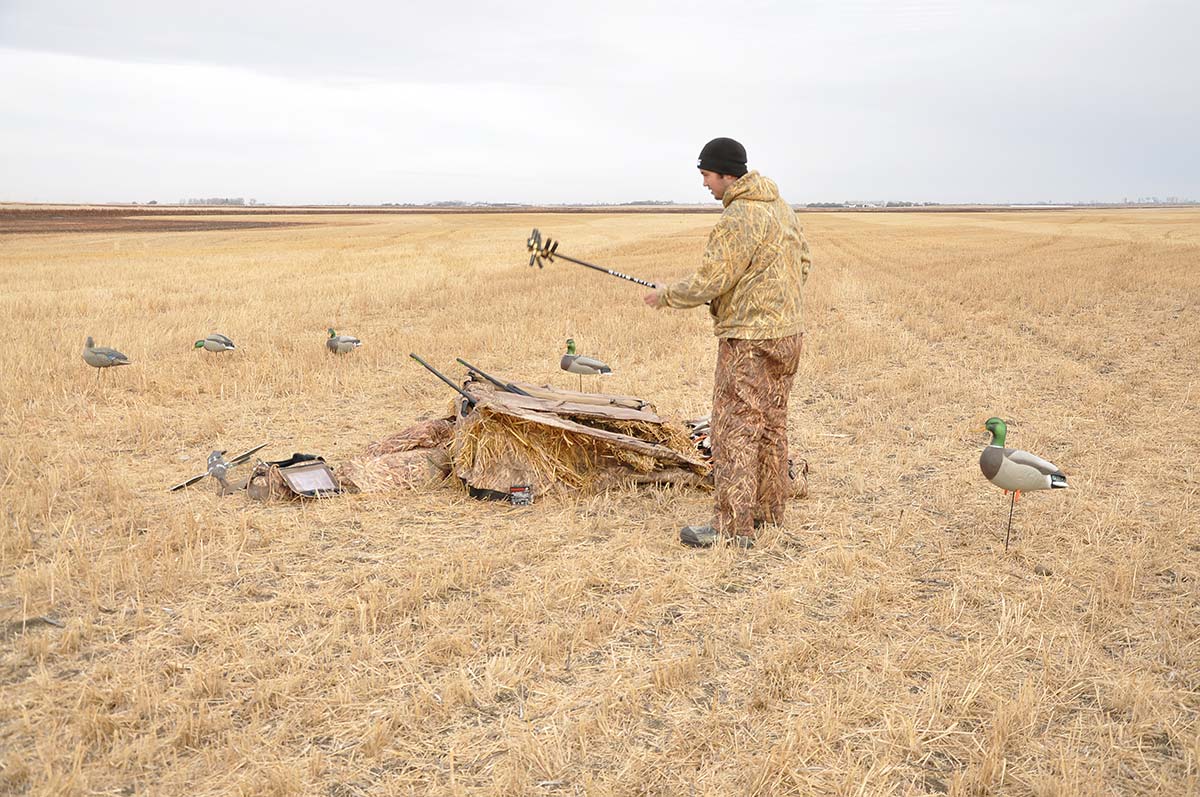
Even though you will be in a blind I suggest wearing full camouflage as there will be times you will get caught out of the blind or when ducks may see into your blind. It can often be cold waiting for the ducks to come, so I suggest wearing a pair of insulated bibs and a couple of upper body layers along with an insulated jacket. The insulated bibs not only keep you warm, but also prevent stubble from sliding down your pants. Layering allows you regulate your body temperature as you will heat up setting out decoys and cool down waiting for the ducks to come. When looking at hunting clothing, look for gear that is wind resistant and at a minimum water resistant. Banded Hunting Gear makes some very comfortable and warm insulated clothing in a number of camouflage patterns to blend in to the environments where you hunt. A pair of insulated boots will also help keep your feet warm.
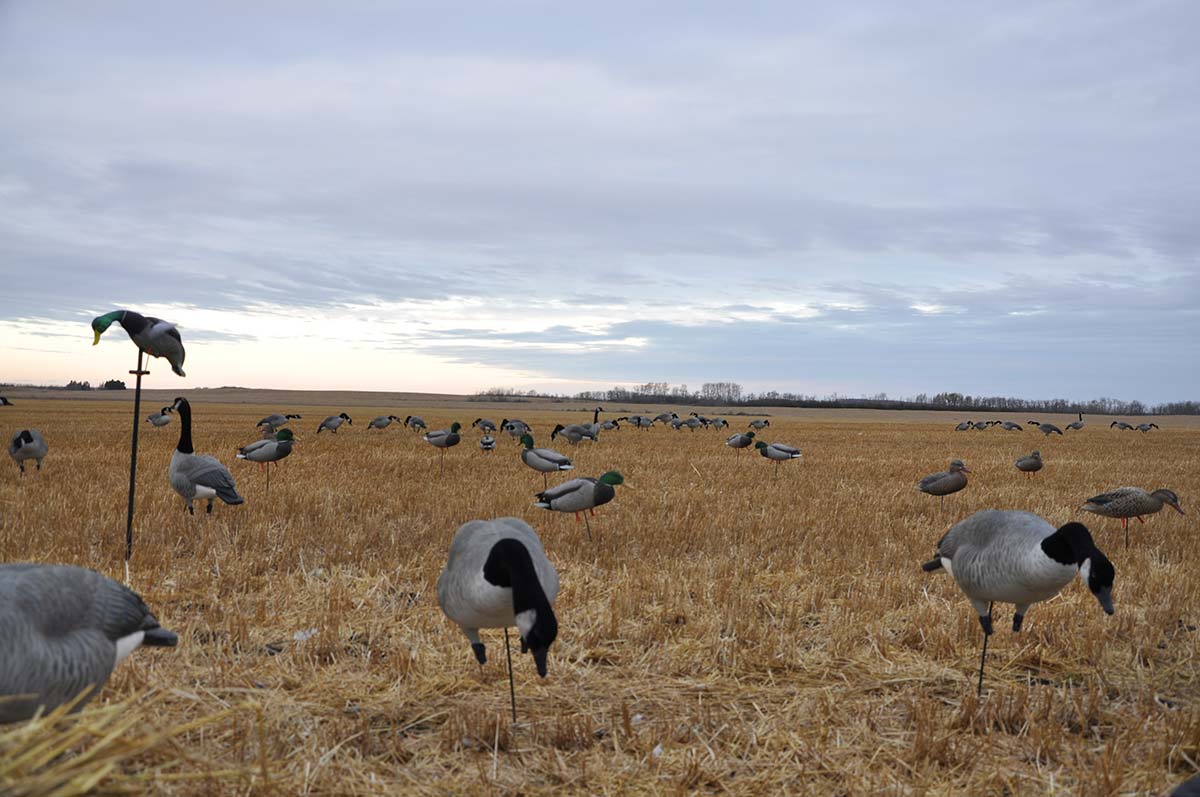
Field Decoys
Ducks aren’t fussy about who they feed with and will come into a spread of duck decoys, goose decoys or a mixed spread of duck and goose decoys. With that said, I like to set up a spread of mixed duck and goose decoys when targeting ducks in stubble fields. The goose decoys are bigger than duck decoys and can be seen by the ducks at a farther distance which helps keep them on course. The goose decoys may also pull in some bonus geese at the same time.
Over the years, I’ve noticed that ducks will often land amongst the duck decoys in a mixed spread. After noticing this, I now set up my duck decoys near my blind and ensure to line the edges of my landing zones with duck decoys for closer shooting opportunities.
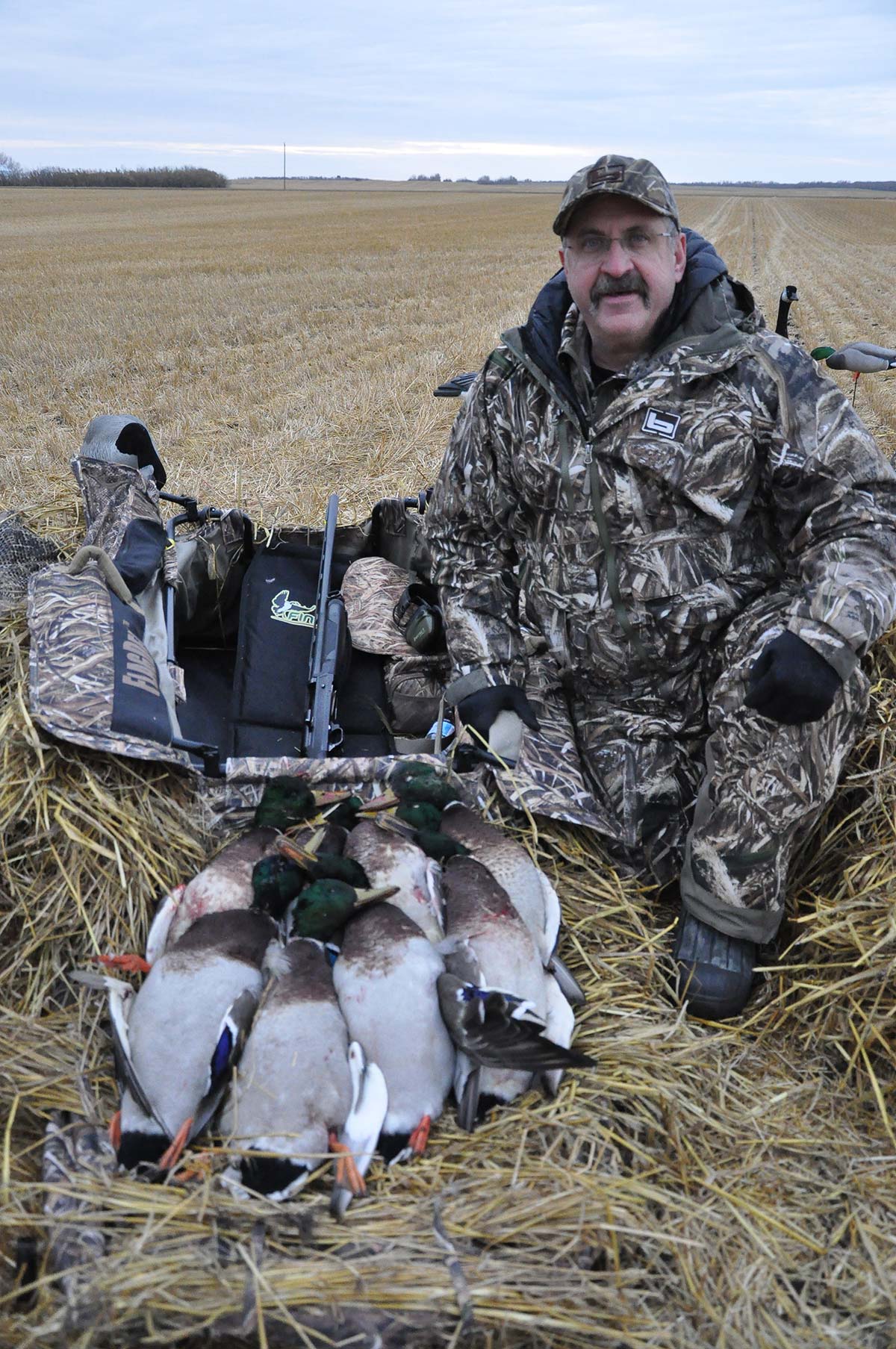
Given the action of a feeding flock of ducks, it is imperative to add motion to a stubble field duck setup. Most shell and full body decoys can be set on motion stakes and there are also windsock style decoys available. Both styles of decoys will move like waddling birds with even the slightest of breezes to bring a spread to life. I personally like to run a 50/50 split of motion and stationary decoys and really like to use GHG Hunter Series Over Size Mallard Shell Decoys in my setup as they are highly realistic, quick to set up and easy to store.
Ducks feed in big numbers, so as a general rule of thumb, I set out at least 120 decoys for a duck hunt with one or two hunting buddies. If more hunters join our group, I like to add another 4 dozen decoys per hunter. This year, Banded has added some super life like GHG Pro-Grade Silhouette Decoys silhouette duck decoys to their lineup. These decoys are super lightweight, easy to set up and are a good way to add numbers to a field spread.
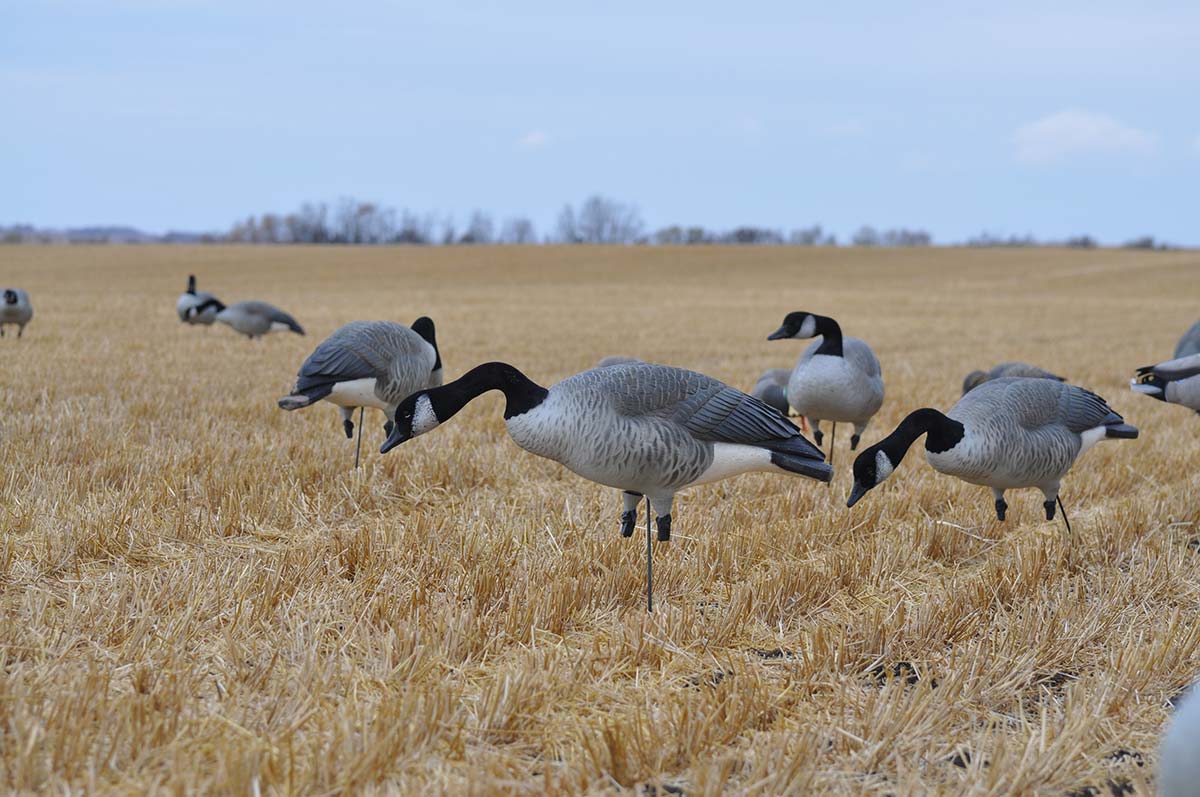
Spinners
In Saskatchewan where I do most of my waterfowl hunting, we are allowed to use spinning winged decoys while hunting waterfowl. I’ll typically use one to six Mojo Duck Decoys
in my field set ups to give the impression of ducks landing in the spread. For the most part, I set up the spinners in the middle of my landing zone. However, on those early season hunts if the ducks are attempting to land too close to the blinds, I will move the spinners behind the blinds.
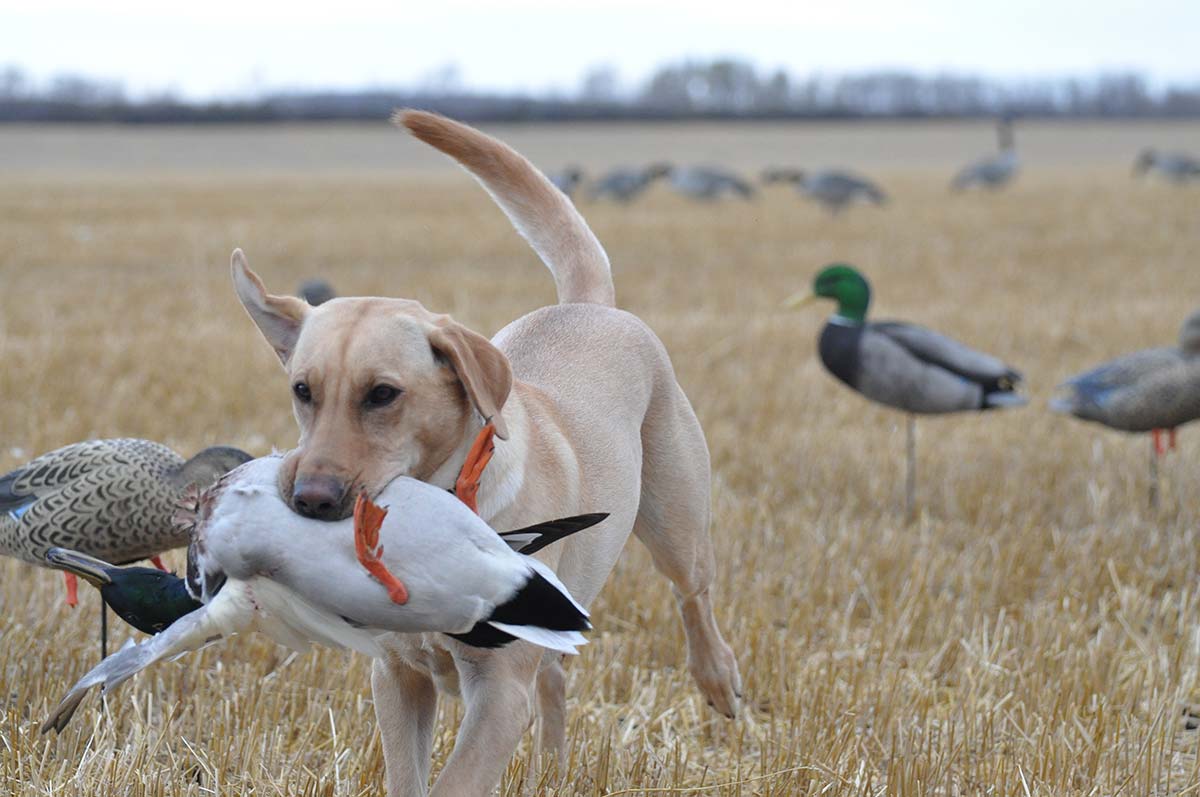
When setting up the spinners, I will often set them up in pairs perpendicular to one another, so the incoming ducks will see motion as they circle the spread. I will watch the ducks to see how they react to the spinners. On most days, the ducks are attracted to the spinners and will keep on coming right to them. On some days, the spinners will attract the attention of distant birds but flare them as the circle closer. Under these circumstances, I will run the spinners to catch the attention of the ducks and then turn them off once I see the ducks headed my way.
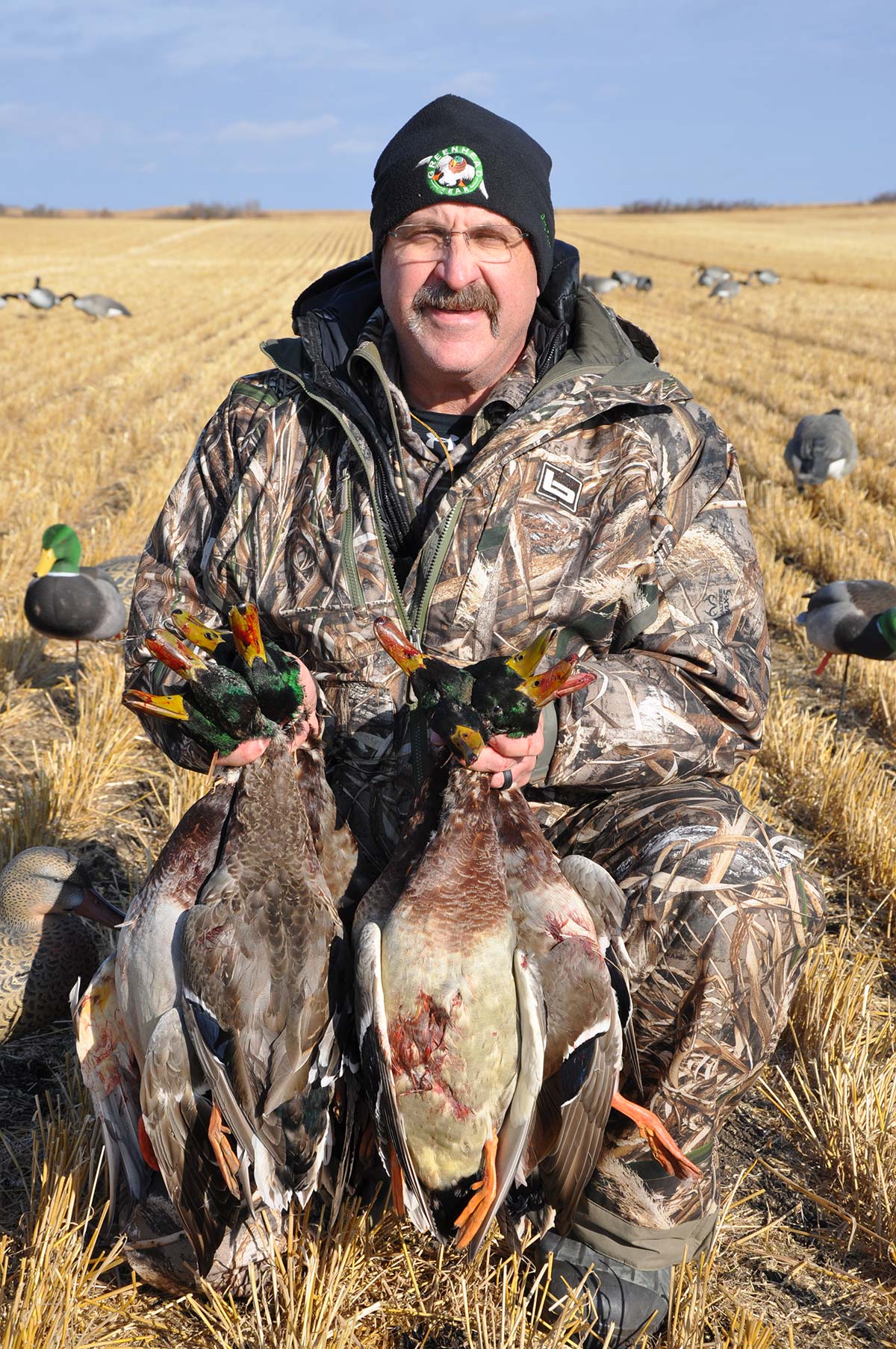
Shotgun and Shotgun Shells
I like to use a semi-automatic shotgun while field hunting for ducks. I like the fact that these guns are fast shooting to keep up with the ducks as they back peddle once shot at. But what I really like is that autoloaders absorb a lot of recoil making it more comfortable to shoot from a layout blind. My choice of shotgun is the Super Black Eagle 3 Shotgun as it has a feature where you can slip out your duck load from the chamber and replace it with a goose load should some geese approach the decoys.
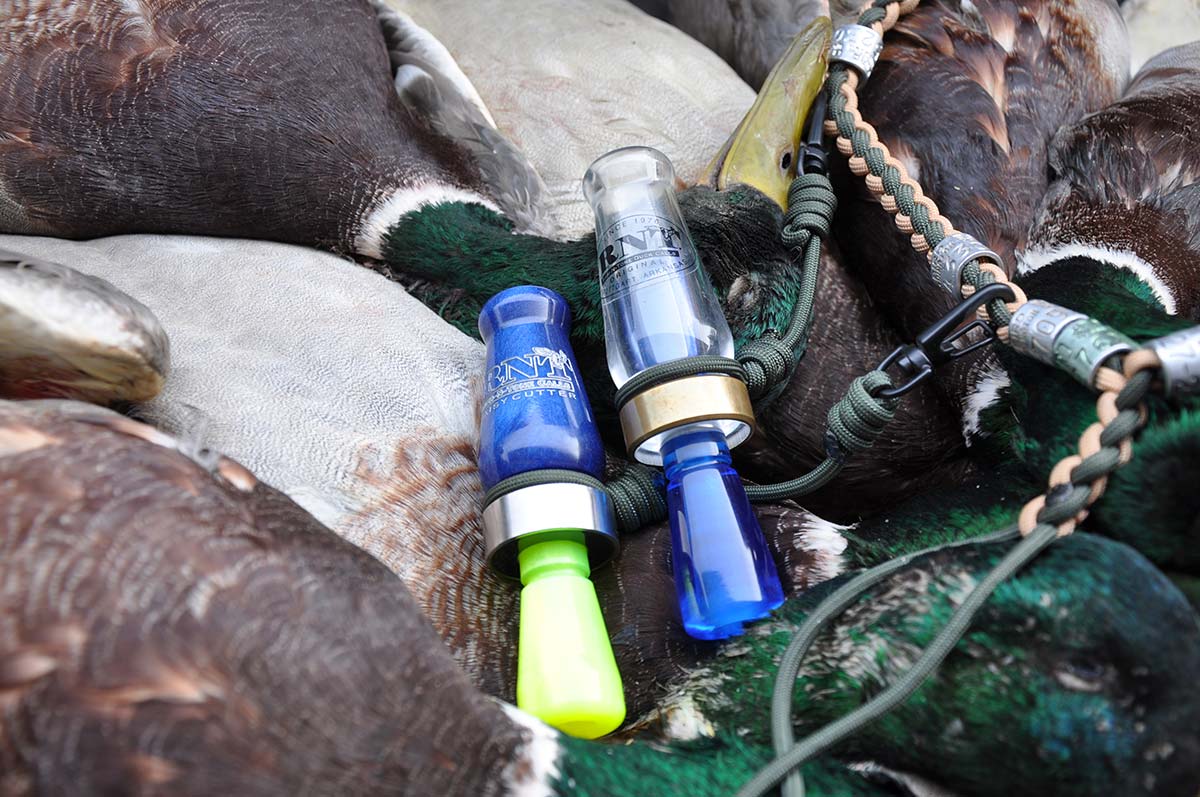
When shooting ducks in stubble fields, I use the factory modified choke tube that came with my shotgun. Over the years of I have done a fair amount of pattern testing of loads and choke tubes. The modified chokes pattern most effectively out to 40 yards and are perfect for this style of hunting. Improved cylinder choke tubes pattern well inside of 30 yards but the patterns get too wide beyond that range resulting in misses and potentially crippling birds with stray pellets once the birds start back peddling. Full choke tubes pattern very tight for the first 40 yards and then open up to effective patterns in the 40 to 50 yard range. On the close-range shots that are the norm with decoying ducks, the tight pattern will result in lots of misses or blown up birds.
Ducks are small but tough targets. They need to be hit in the front third of their bodies to fold up and drop so it is important to keep swinging the barrel after pulling the trigger. Over the years, I’ve taken ducks with both 20 and 12 gauge shotguns using shot sizes ranging from BB’s to number 6’s. However, my go to load is 12 gauge 3” Winchester Blind Side 2 shotshells in size 3 shot as I find these unique hex shaped steel pellets retains down range velocity, which equates to higher energy and impact for one shot kills.
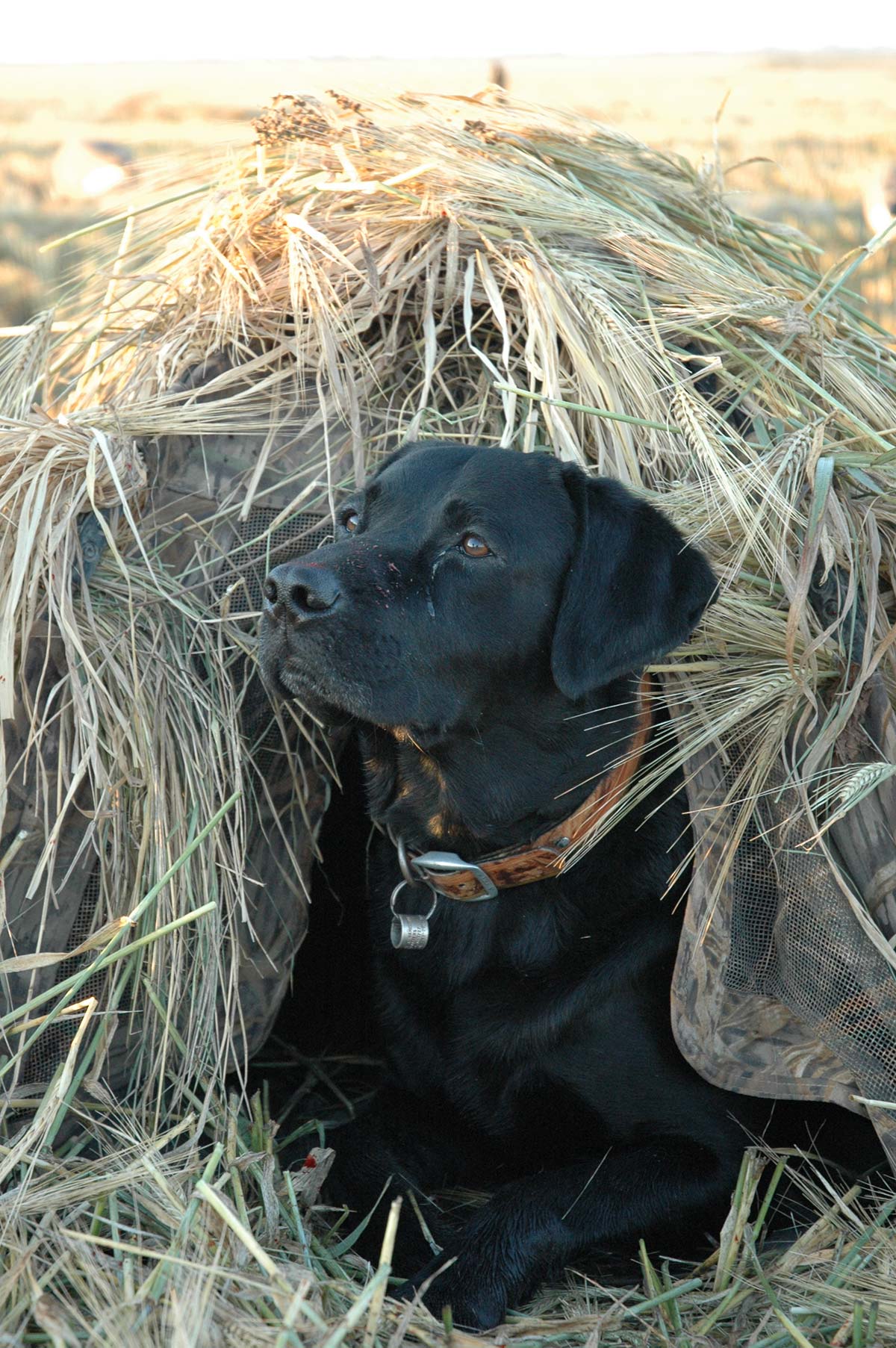
To keep the landowners happy where you hunt, it is always a good idea to pick up your spent shotgun shells. Autoloaders will throw shells a few feet away so make sure you look beyond your blinds for empties. While you can crawl on your hands and knees to find empties, I prefer to us a MOJO Pick Stick Magnetic Shotgun Shell Retriever as you can walk around the blinds and decoys and pick up shells without bending over, saving energy to pick up the decoys and clean birds.
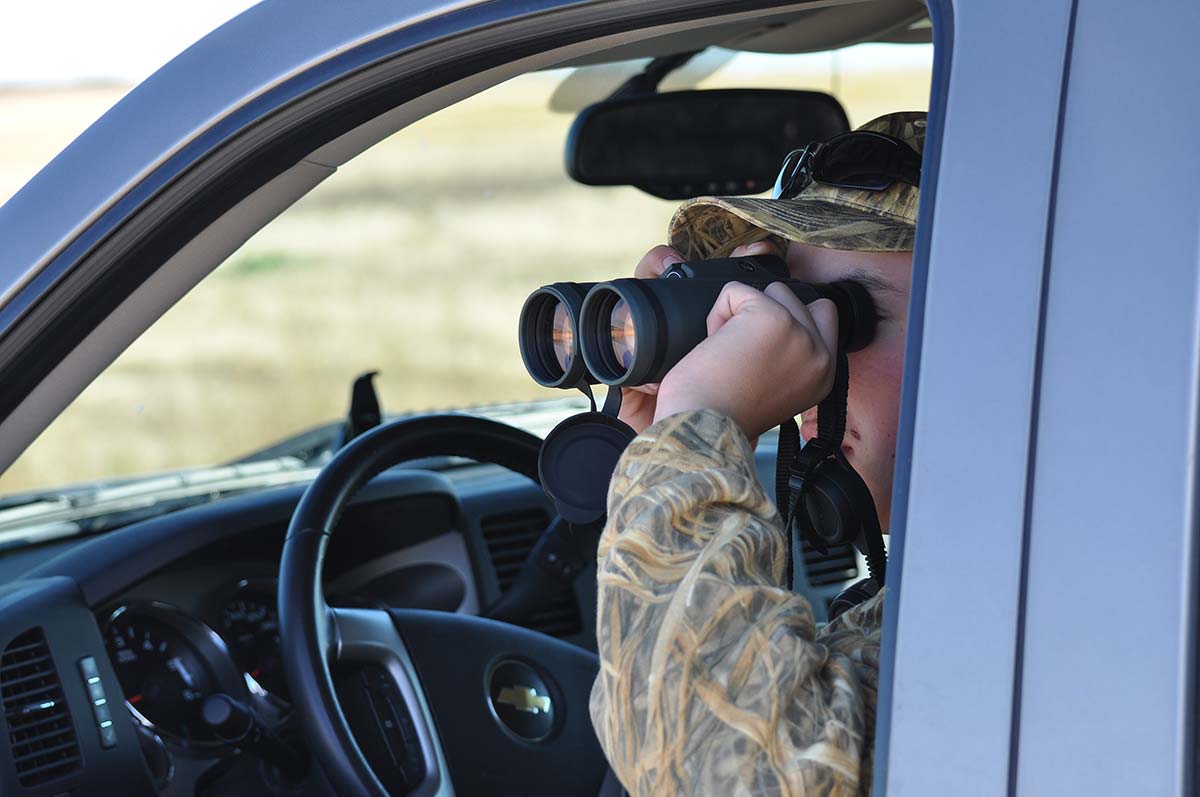
Duck Calls
Calling ducks is so much fun as they respond well to a call. A hail call will catch their attention at a distance and have them come towards that call. Feeding chuckles will instill confidence in circling ducks and make them think your decoys are live birds. Often, ducks will respond to quacks and it is just pure fun to talk to them and pull them towards the ground.
When hunting over stubble fields, I like to use acrylic calls as both the loud and soft calls they produce are crisp, sharp and realistic sounding. My go to call is the RNT Daisy Cutter Duck Call
as I love the sounds I can make with it. However, on some days I can’t get the reaction out of the ducks with that call, so I also carry an RNT Original and Mondo duck calls on my lanyard, to produce calls with slightly different tones and pitches.
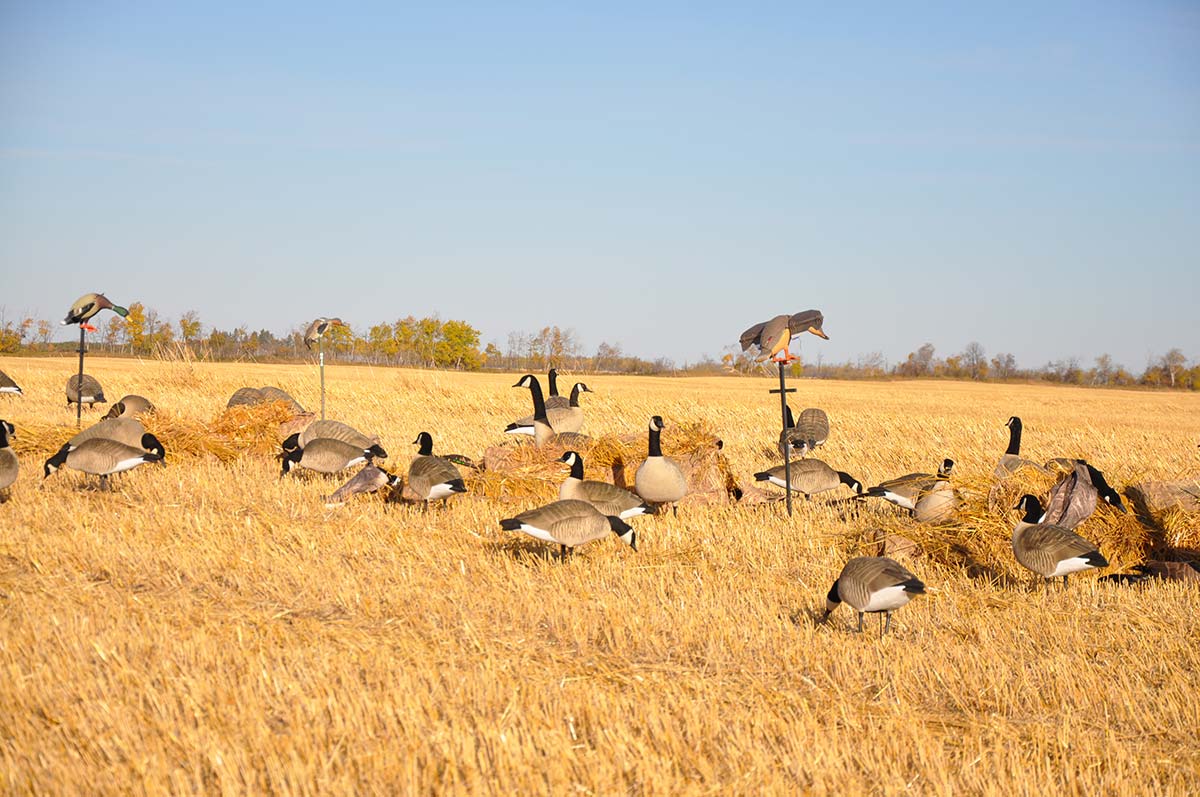
Per our affiliate disclosure, we may earn revenue from the products available on this page.

